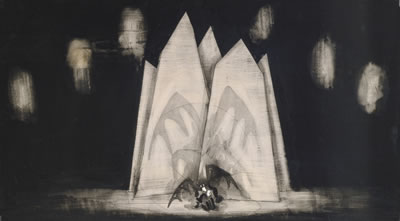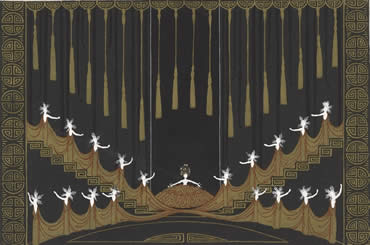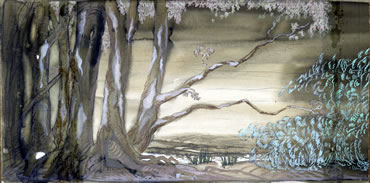 |  |  | |
News & Notices
News From:
Commissions
Conference & Stage Expo
For the Record
 | An Abstraction for Arnold Schönberg’s Opera - Pantomime Die Glückliche Hand (The Hand of Fate), 1930 by Robert Edmond Jones. Gift of Mrs. Donald M. Oenslager to the Morgan. Photography by Schecter Lee, 2009. | |
| Exhibition Examines Artistry, Innovation Of 20th-Century Stage Design The 20th century saw a renaissance in the art of the theatre. Modern technology and materials allowed for innovative approaches to stage sets. New theories concerning the role of the actor and set in theatrical performances encouraged a radical departure from long-standing practices and the literalism of the 19th-century stage. Imagination and vision were encouraged allowing a vital and varied stagecraft to emerge throughout England, Europe, Russia, and America. This extraordinary period of innovation in modern scenic design is the subject of an exhibition, Creating the Modern Stage: Designs for Theatre and Opera at The Morgan Library & Museum in New York City. It runs through August 16. The exhibition features more than 50 drawings from the Morgan’s holdings, principally from the collection formed by American set designer Donald Oenslager (1902–1975). Enriching these colorful drawings is related material that includes musical scores, rare books, and autograph manuscripts as well as more than 30 performance photographs documenting the finished set. The exhibition is divided into four thematic sections -- Origins of Modern Scenic Theory, Destroying Tradition, the Russian Avant-Garde, and Diversity of the American Stage -- together emphasizing the international scope of advances in set design. Origins of Modern Scenic Theory The exhibition opens with visionary drawings for the stage by Edward Gordon Craig (1872–1966) as well as texts fundamental to modern scenic theory by Craig and Swiss stage designer Adolphe Appia (1862–1928). Appia spurred a move toward visual simplicity and a unity of aesthetic elements in set design and direction in part through his 1899 book, Die Musik und die Inscenierung (Music and Set Design). Craig’s Art of the Theatre (1905) set out principles for an imaginative and suggestive, rather than literal, approach to set design. Destroying Tradition At the beginning of the 20th century, ideas about the new stagecraft spread throughout Europe. A synthesis of the arts was elemental to several avant-garde movements, such as the Austrian Sezession and the German Jugendstil. Artists became more involved in the theatre, revitalizing scenic design and resulting in new and daring productions. The break from aesthetic tradition is documented in dramatic designs by German Expressionists. During and immediately following World War II when materials were scarce, Berlin designers’ clever use of available resources continued to push the limits of convention. Dialogue, set, and movement were fused together to create a comprehensive theatrical experience. The Russian Avant-Garde The Moscow Art Theater, founded in 1899, represented the vanguard of innovation. The collaboration between producers and designers, many of whom were painters, yielded an exceptional standard of stagecraft. At the center of this phenomenon was Mir iskusstva (World of Art), a group that emerged in St. Petersburg during the late 1900s. Members Alexandre Benois, Serge Diaghilev, and Léon Bakst designed and executed dance and theatre productions in Moscow and St. Petersburg. Shortly afterward, avant-garde artists Alexandra Exter, Natalia Goncharova, and Nikola? Pavlovich Akimov broke further from conventional set design influenced by Cubism and Constructivism.
Scene design by Erté (Romain de Tirtoff), Russian, for the Ziegfeld Follies, 1923. Gift of Mrs. Donald M. Oenslager to The Morgan. Photography by Schecter Lee, 2009. Diversity of the American Stage On stages throughout the United States, the vaudeville tradition of the early years of the 20th century gave rise to the genre of musical theatre, a distinctly American art form. Actors were in demand for both stage and screen, and the Depression inspired socially conscious plays as well as comedies. American theatre also benefited from an influx of European and Russian designers, who brought their experience to New York and other major theatre centers in the United States. A new American stagecraft originated largely in the work of Robert Edmond Jones (1887–1954), one of the principal designers responsible for its reinvigoration. He aimed to unify the elements of acting, lighting, and setting through his dramatic use of abstract forms and lyrical tonal effects. Eugene Berman is one of the best known New York stage designers of the 1940s and 1950s. Born in Russia, he fled during the revolution and worked in Paris before emigrating to America in 1940. As a set designer, he rejected the abstract aesthetic established by Appia and Craig in favor of more evocative, elegant, and richly colored settings, often on a vast scale and replete with ruins and mysterious light. As a young man, Donald Oenslager began collecting drawings, rare books, and prints related to the theatre dating from the 16th through the 20th centuries. Totalling approximately 1,600 sheets, the collection was presented to the Morgan by his widow in 1982. Creating the Modern Stage: Set Designs for Theatre and Opera is organized by Jennifer Tonkovich, curator of drawings and prints, with the assistance of Elizabeth Nogrady, Moore Curatorial Fellow, The Morgan Library & Museum. The exhibition was made possible through the generosity of Jane and Robert Carroll and Eliot and Wilson Nolen. Generous assistance was also provided by the David L. Klein Jr. Foundation and the Tobin Theatre Arts Fund. This program is supported, in part, by public funds from the New York State Council on the Arts and the New York City Department of Cultural Affairs.
Donald Oenslager’s design of the Banks of the Salinas River for Steinbeck’s Of Mice and Men, 1937. Gift of Mrs. Donald M. Oenslager to The Morgan. Photography by Schecter Lee, 2009. | ||
United States Institute for Theatre Technology, Inc.: © 2009 VolumeXLIX, Number 8

